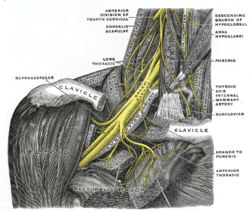Dorsal scapular nerve
| Dorsal scapular nerve | |
|---|---|
 The right brachial plexus with its short branches, viewed from in front. (Dorsalis scapulae labeled at left, second from top.) | |
| Details | |
| From | C5 of brachial plexus |
| Innervates | rhomboid minor, rhomboid major, levator scapulae |
| Identifiers | |
| Latin | nervus dorsalis scapulae |
| TA98 | A14.2.03.011 |
| TA2 | 6409 |
| FMA | 65279 |
| Anatomical terms of neuroanatomy | |
The dorsal scapular nerve is a branch of the brachial plexus. It supplies rhomboid major muscle, rhomboid minor muscle, and levator scapulae muscle. It causes the scapula to be moved medially towards the vertebral column. Dorsal scapular nerve syndrome can cause a winged scapula, with pain and limited motion.
Structure[]
This section needs additional citations for verification. (January 2022) |
The dorsal scapular nerve arises from the brachial plexus, usually from the plexus root (anterior/ventral ramus) of the cervical nerve C5.[1][2][3] Once the nerve leaves C5 it commonly pierces the middle scalene muscle.[1] It continues deep to levator scapulae muscle and the rhomboids (minor superior to major).[1]
The nerve is accompanied by one of two arteries: either the dorsal scapular artery (the only artery that branches off the third part of the subclavian artery, although its origin is highly variable in humans) or, when the dorsal scapular artery is absent, the deep branch of the transverse cervical artery. The latter is one of three arteries branching off the thyrocervical trunk, a branch of the first part of the subclavian artery, with the other two branches being the suprascapular artery, and the inferior thyroid artery.
Function[]
The dorsal scapular nerve provides motor innervation to the rhomboid muscles.[2][3] These pull the scapula medially towards the vertebral column.[2][3] It also provides motor innervation to levator scapulae muscle.[2][3] This elevates the scapula.[2][3] This helps to stabilise the scapula.[4]
Clinical Significance[]
Injury to the dorsal scapular nerve is usually apparent on inspection when the scapula on the injured side is located farther from the midline than the uninjured scapula. The patient would be unable to pull their shoulder back, as when standing at attention. Isolated dorsal scapular nerve injury is uncommon, but case reports usually involve injury to the scalene muscles.[5]
The dorsal scapular nerve is typically not anaesthetised during a supraclavicular nerve block.[6] This can cause pain after some surgeries.[6]
Dorsal scapular nerve syndrome[]
Dorsal scapular nerve syndrome can be caused by nerve compression syndrome. A winged scapula is the most common symptom.[7] Shoulder pain may occur.[7] It causes weakness in rhomboid major muscle, rhomboid minor muscle, and levator scapulae muscle.[7] The range of motion of the shoulder may be limited.[7] Treatment is usually conservative.[7]
See also[]
Additional images[]

Brachial plexus

Brachial plexus with courses of spinal nerves shown

Deep Branch of Transverse Cervical running with Dorsal Scapular
References[]
- ^ a b c Tubbs, R. Shane; Goodrich, Dylan; Watanabe, Koichi; Loukas, Marios (January 1, 2015), Tubbs, R. Shane; Rizk, Elias; Shoja, Mohammadali M.; Loukas, Marios (eds.), "Chapter 43 - Anatomic Landmarks for Selected Nerves of the Head, Neck, and Upper and Lower Limbs", Nerves and Nerve Injuries, San Diego: Academic Press, pp. 575–588, doi:10.1016/b978-0-12-410390-0.00045-7, ISBN 978-0-12-410390-0, retrieved November 2, 2020
- ^ a b c d e Felten, David L.; O'Banion, M. Kerry; Maida, Mary Summo (2016), "Peripheral Nervous System", Netter's Atlas of Neuroscience, Elsevier, pp. 153–231, doi:10.1016/b978-0-323-26511-9.00009-6, ISBN 978-0-323-26511-9, retrieved November 2, 2020
- ^ a b c d e Ma, Yun-tao (January 1, 2011), Ma, Yun-tao (ed.), "CHAPTER 8 - Neuroanatomy of Acu-Reflex Points", Acupuncture for Sports and Trauma Rehabilitation, Saint Louis: Churchill Livingstone, pp. 88–131, doi:10.1016/b978-1-4377-0927-8.00008-7, ISBN 978-1-4377-0927-8, retrieved November 2, 2020
- ^ Loftus, Brian; Athni, Sudhir; Cherches, Igor (January 1, 2010). "Chapter 2 - Clinical Neuroanatomy". Neurology Secrets (5th ed.). Mosby. pp. 18–54. doi:10.1016/b978-0-323-05712-7.00002-7. ISBN 978-0-323-05712-7.CS1 maint: date and year (link)
- ^ Akuthota, Venu; Herring, Stanley A. (May 28, 2009). Nerve and Vascular Injuries in Sports Medicine. Springer Science & Business Media. ISBN 9780387766003 – via Google Books.
- ^ a b Williams, Brain A.; Neumann, Krystof J.; Goel, Shiv K.; Wu, Christopher L. (2008). "14 - Postoperative Pain and Other Acute Pain Syndromes". Raj's Practical Management of Pain (4th ed.). Mosby. pp. 299–334. doi:10.1016/B978-032304184-3.50017-0. ISBN 978-0-323-04184-3.
- ^ a b c d e Rea, Paul (January 1, 2015). "Chapter 2 - Upper Limb Nerve Supply". Essential Clinically Applied Anatomy of the Peripheral Nervous System in the Limbs. Academic Press. pp. 41–100. doi:10.1016/B978-0-12-803062-2.00002-4. ISBN 978-0-12-803062-2.CS1 maint: date and year (link)
External links[]
- Dorsal_scapular_nerve at the Duke University Health System's Orthopedics program
- Nerves of the upper limb
